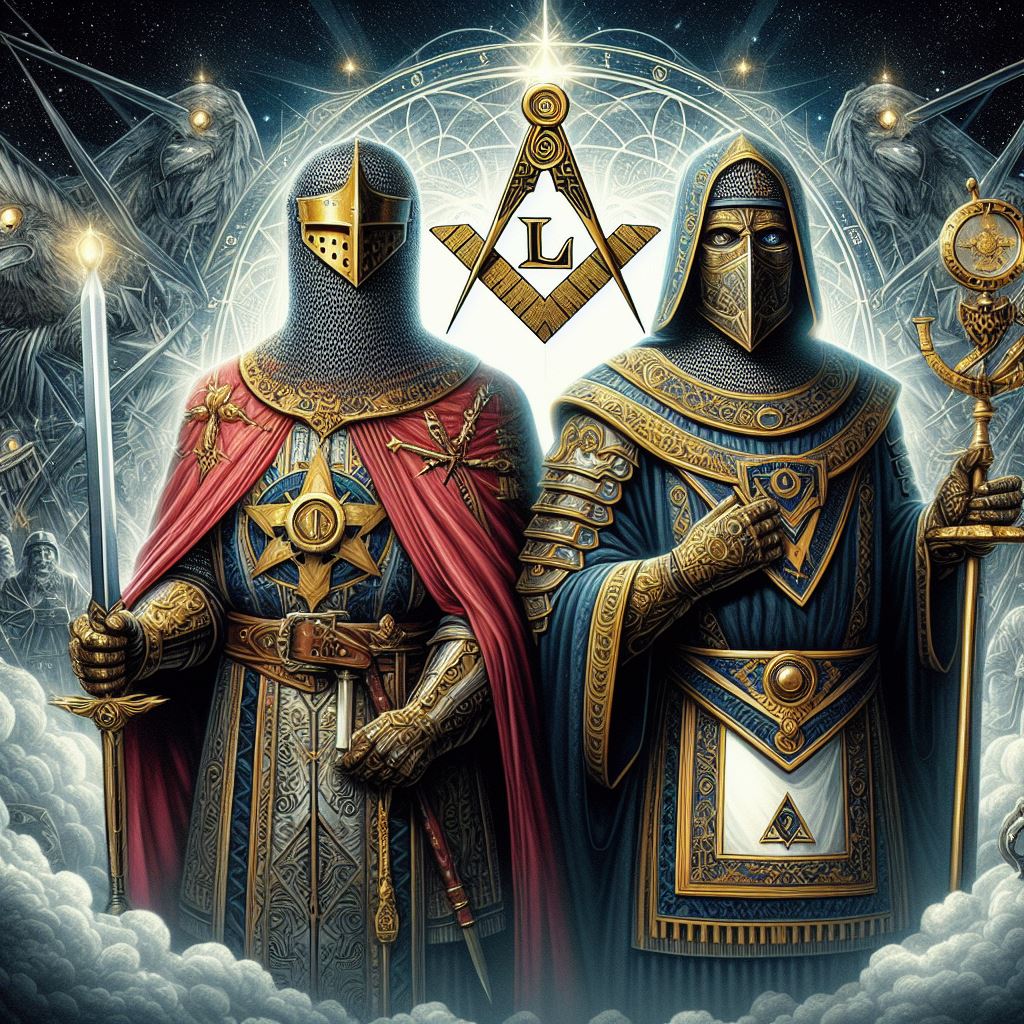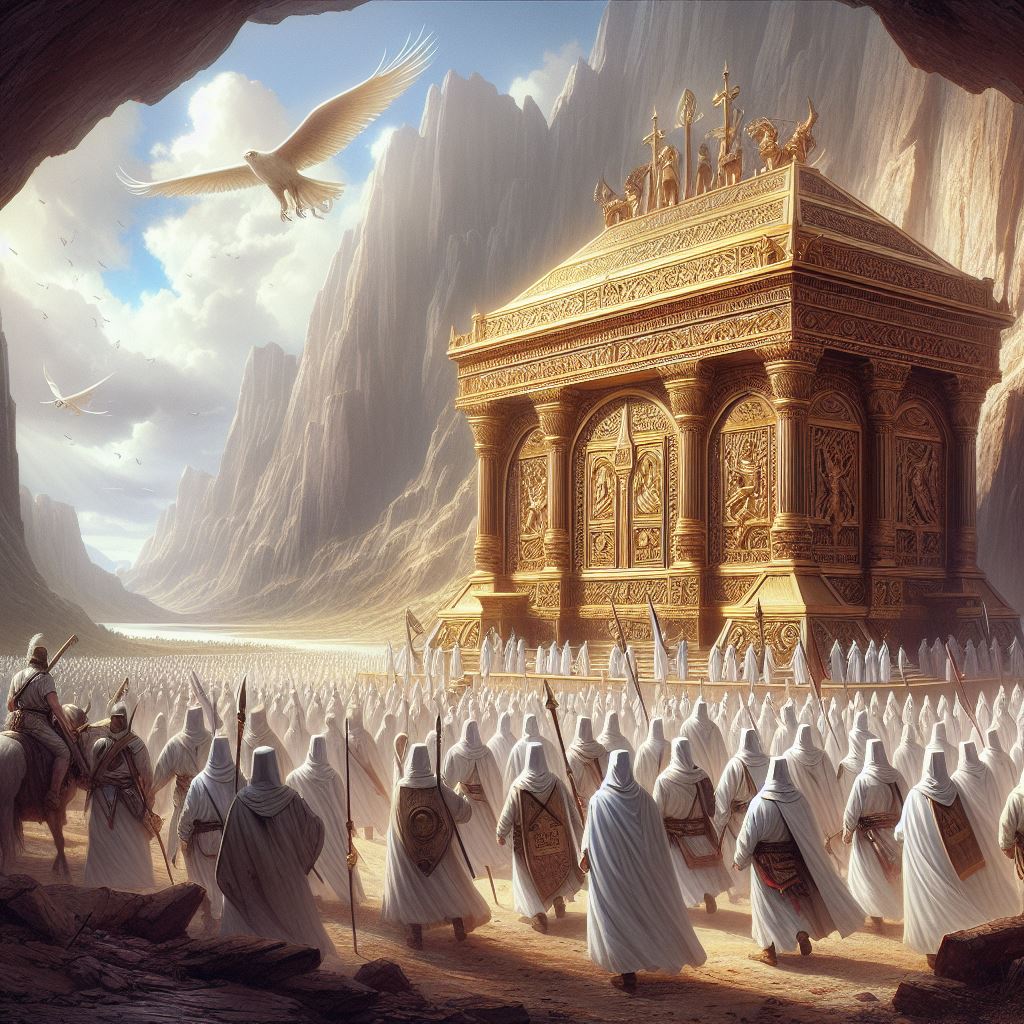SPECIAL INVESTIGATION: THE PRIORY OF SION

One of the great mysteries and contentious discussion points about the Knights Templar is whether the order was established by an already existing secret society called the Priory of Sion. This, as you will know, underlies the plot behind Dan Brown’s The Da Vinci Code.
The story goes that the Priory of Sion was formed to protect the sacred bloodline of Jesus Christ from the Catholic church, which feared the threat to its power and the terrible truth that would fatally undermine the papacy’s authority and fabulous wealth.
The Messiah had conceived at least one child with Mary Magdalene, who had fled to France after the crucifixion. Her descendants were the Merovingian kings overthrown in the eighth century CE who ruled over a large part of modern France, Germany and Switzerland.
The priory’s aim was to reinstate the dynasty and establish a Christian theocracy over Europe ruled by the descendants of Jesus. The Knights Templar had been formed by the priory to achieve this objective, whatever the official reasons given for their creation.
Subsequent centuries had seen a secret battle played out between different forces including the priory, the Templars, the church and Freemasons. They were fighting and scheming for control of the Holy Grail. But what exactly was the Grail? A physical object like a cup used at the Last Supper or the bloodline of Jesus Christ? The so-called Sang Real?
This is all of course discounted by mainstream medieval historians as hokum. The history of the Knights Templar, in their view, does not require additional layers of fantasy to be fascinating. The Priory of Sion is utter nonsense invented by con artists and spread by the credulous. Well, below, we’re going to examine the case for the existence of the Priory of Sion and the case for the prosecution.
First – let’s hear from the defence – those who believe the Priory of Sion was very real.

Case for the Defence
- The Priory of Sion was founded in Jerusalem after the First Crusade resulted in the capture of the city by Christian forces in 1099. It was based on the site of the Byzantine Hagia Sion, which subsequently housed a monastic order called the Abbey of Our Lady of Mount Zion. The Priory and Abbey were one and the same thing. This church was the site of the bodily and spiritual “assumption” of the Virgin Mary into heaven (in Catholic dogma). It’s now under the control of the Benedictines.
- The Priory of Sion founded the Knights Templar to achieve its hidden objectives. This was to protect the bloodline of Jesus – the real Holy Grail. The term Holy Grail means “Sang Real” or Royal Blood. The Templars were the Grail Knights spoken of in legend. It was their role and destiny to defend the Grail, the bloodline, at all costs. This they would do until the time came to make the bloodline known to humanity.
- A 19th century French priest François-Bérenger Saunière (pictured above) discovered the truth about the Priory of Sion after being sent to run a church in the French village of Rennes-le-Château. The church was dedicated to Mary Magdalene, wife of Jesus Christ, who had fled to France after the crucifixion. While in this role, Saunière installed the statue of the Virgin Mary at Lourdes, the hugely popular pilgrimage site. He was a pious cleric who believed he had stumbled on a great truth.
- Saunière seemed to become very rich, very quickly. He built a large estate between 1898 and 1905 that included the Rococo-style edifice, Villa Bethania and the Tour Magdala with an orangery. The 1998 novel Menorah conjectures that Saunière had found the seven-branched candelabra of the Temple of Jerusalem, destroyed and sacked by the Romans.
- In the 1982 book The Holy Blood and the Holy Grail it was pointed out that Rennes-le-Chateau was located close to the ancestral home of Bertrand de Blanchefort, fourth Grand Master of the Knights Templar. The three authors of the book wondered if Blanchefort had buried Templar treasure in the vicinity. They believed that during the second world war, German soldiers had very likely excavated the area. Why? Because the Nazis, obsessed with the occult, were aware that their favourite composer Richard Wagner had visited Rennes-le-Château and shortly afterwards written his opera Parsifal, based on a medieval Grail quest story of the same name. Wagner knew that Rennes-le-Château was concealing a Grail mystery.
- The book detailed how in 1891, Saunière had the altar stone removed in his church and inside one of two Visigothic pillars supporting it, discovered four parchments in sealed wooden tubes dating from between 1244 to the 1780s.
- The 1780s parchments were the most interesting authored by a priest called Antoine Bigou who was the chaplain to the Blanchefort family just before the 1789 French Revolution. They appeared to be texts from the New Testament in Latin but were written rather oddly and clearly contained coded messages. They became the subject of three documentaries made for the BBC in the 1970s by one of the authors of The Holy Blood and the Holy Grail, Henry Lincoln. It referred to the last Merovingian king, Dagobert II, as follows once decoded: “To Dagobert II, king, and to Sion belongs this treasure and he is there dead.”
- Another parchment contained the enigmatic message: “Shepherdess, no temptation. That Poussin, Teniers hold the key. Peace 681. By the cross and this horse of God. I complete this daemon of the guardian at noon. Blue apples.”
- Saunière made the discovery of the parchments known to the bishop of Carcassonne who, realising their importance, sent him to Paris straight away. While there, visiting clerics and mixing with society people, he went to the Louvre to acquaint himself with the Poussin painting The Shepherds of Arcadia, long believed to include a Templar related secret message.
- Saunière returned to Rennes-le-Château and embarked on a bizarre redecoration of his church that included a representation of the demon Asmodeus who, in Talmudic legends, built the Temple of Solomon. In Kabbalistic circles, Asmodeus was the offspring of King David and the queen of the demons, Agrat bat Mahlat.
- On 22 January, 1917, Saunière suffered a stroke and died. The huge estate he had built was passed to his long serving housekeeper Marie Denarnaud. Gradually sliding in to genteel poverty after the second world war, Denarnaud sold the estate to a businessman called Noël Corbu (1912-1968). She promised to confide a secret to Corbu that would make him rich and powerful but tantalisingly died before she could impart this knowledge.
- The author Dan Brown took the story of these hidden parchments and brought the story of the Priory of Sion back to public prominence with his book The Da Vinci Code. The adventure starts with the murder of a curator at the Louvre called Jacques Saunière (same name as the priest who served at Rennes-le-Château) , who also happens to be the Grand Master of the Priory of Sion. His killer is a Catholic monk under the direction of a “teacher” who wants to use the secret of the Holy Grail to destroy the Vatican. The real meaning of the Holy Grail is the bloodline of Christ and it leads the book’s hero to the sarcophagus of Mary Magdalene, located under the Louvre.
- Dan Brown has asserted strongly that the Priory of Sion is fact and not fiction.
Case for the Prosecution

- The Prioriy of Sion was an invention of a French convicted fraudster called Pierre Athanase Marie Plantard (1920-2000 and pictured above). In 1953, he served a six-month prison sentence for fraud. This was revealed in a BBC2 programme called The History of a Mystery, part of the “Timewatch” documentary series. Timewatch was the successor to an earlier documentary strand called “Chronicles”, which in the 1970s had promoted the whole Priory of Sion thesis.
- Three years after his prison sentence, with an accomplice called André Bonhomme, Plantard created an organisation called The Priory of Sion in 1956. Bonhomme was president and Plantard was secretary general. Initially, it was not intended to be viewed as an ancient sect pre-dating the Templars, but just a pressure group campaigning for better local housing. It also took a traditionalist Catholic line and wanted to work with the local church on things like running a school bus service. Sion refers to a hill near the town of Annemasse where Plantard lived in the Auvergne region of France. The priory folded later the same year.
- Enter Robert Charroux, a man who believed that aliens had visited humanity in ancient history and imparted wondrous knowledge. A very similar theory was popularised in the 60s and 70s by the Swiss author Erich Von Däniken with his book Chariot of the Gods. In 1962, Charroux wrote a book Trésors du monde. It gave details of hidden treasures all over the world. Charroux had come across the aforementioned Noël Corbu who had bought the estate built by the priest Saunière. Corbu had serialised a story in the local paper claiming that the priest Saunière had discovered all or part of a 28.5 million gold pieces fortune gathered by Blanche of Castile to pay the ransom on King Louis of France during the Crusades, when he was being held prisoner by the Saracens in Egypt. This was detailed, he claimed, in the parchments found in the pillar of the altar in his church by Saunière. Cynics countered that Corbu was just trying to drum up business at his restaurant.
- A great deal is made of the sudden wealth acquired by Saunière as proof that he had indeed found part of the wealth of Blanche of Castile and possibly other treasure. The reality, as evidenced by several church disciplinary hearings and the stripping of his priesthood, is that he was utterly corrupt, selling masses which was against church law. This view was corroborated by a local historian, René Descadeillas, in 1974 as well as a Channel 4 documentary in the UK called The Real Da Vinci Code broadcast in 2005 and a CBS 60 Minutes investigation, Priory of Sion, aired the following year. All came to the conclusion that Saunière’s wealth did not derive from discovering secret treasure but by exploiting his gullible parishioners.
- CBS also questioned the veracity of the discovered parchments and revealed that Plantard had been investigated by the French secret services during the second world war and described as a “fantasist”. He had come to their attention as an extreme right-wing activist.
- Plantard seems to have latched on to the Corbu story and developed it. In fact, all the protagonists in this conspiracy theory grabbed the Priory of Sion story baton and ran with it awhile – developing new angles before handing it on to another author.
- Plantard and others then developed a lineage for the Priory of Sion transporting it back way beyond 1956 into the mists of history. It was linked by Plantard to an abbey in Jerusalem, the Hagia Sion or Church of Zion. This was originally built in the early 5th century, then destroyed by invading Persians and later occupied by a monastic order called the Abbey of Our Lady of Mount Zion. As Plantard rightly pointed out, they were absorbed into the Jesuits in 1617. But experts say that order had nothing to do with Plantard’s Priory of Sion.
- Plantard hooked up with an author called Gérard de Sède (1921-2004) who was the Baron de Lieoux and a man heavily influenced by surrealism. The result was a tome called L’Or de Rennes, the gold of Rennes, published in 1967. The two of them concocted the yarn that the last Merovingian king was buried at Rennes-le-Château in the eighth century and that the Priory of Sion had been working clandestinely ever since to bring the Merovingians back to power.
- Plantard had taken his Priory of Sion organisation from a defunct housing pressure group to an ancient brotherhood protecting the Merovingian line of which he now decided he was a descendant. The central proposition was that a Merovingian monarch would rule France, and possible Europe, fulfilling a prophecy of Nostradamus. Plantard styled himself “Chyren”, a pseudonym referring to “Chren Selin”, an anagram used by Nostradamus to refer to this future king.
- Enter Philippe de Chérisey, another aristocrat influenced by surrealism, who became buddies with Plantard in the early 1960s. He undoubtedly forged medieval parchments, allegedly found by Saunière, to back up the idea of the Priory of Sion being an ancient organisation. With Plantard, he created a load of allegedly secret documents, which they placed in the Bibliothèque Nationale de France (bit like the Library of Congress or the British Library) De Cherisey seems to have viewed these forgeries as a bit of a hoot. In later confessions, he conceded that he enjoyed setting false trails.
- Henry Lincoln, author of Holy Blood Holy Grail, admitted that Plantard had told him De Cherisey had created the documents on which the whole Priory of Sion hoax rests.
- The Italian author and academic Umberto Eco was fascinated by the Knights Templar and the fantasy that surrounds them. He satirised people like Plantard in his book Foucault’s Pendulum where three publishers develop a fraudulent conspiracy theory only to be sucked in to a real one. This is surely a post-modern chuckle at the fantasists and hucksters.
- What we have with the Priory of Sion is a total fabrication half-believed by all those involved.

It sounds pretty damning for Plantard and his Priory of Sion. But then there’s another hypothesis put forward by Templar historian and fantasy writer Graeme Davis in his book Knights Templar A Secret History. Should mention that he also co-designed Warhammer Fantasy Roleplay. Davis argues that the whole point of the Plantard hoax was to throw people off the scent of the real location of the Holy Grail.
In 2007 Davis met an academic who had taught at the University of Toulouse called Dr Émile Fouchet. They were at the International Congress on Medieval Studies. Fouchet shared his notes on the foundation of the Knights Templar with Davis three days before he was killed in a car accident in 2012 just outside Troyes, a town in France with strong Templar connections. Accident? Suicide? Murder? Who knows.
Fouchet developed a complicated account of the Holy Grail being fought over down the centuries by Freemasons, the Inquisition and a secret continuation of the Knights Templar in various guises. One of the Templar tools was none other than Napoleon Bonaparte who they allowed to demolish the Paris Temple to cover his tracks.
The Holy Grail was hidden by the Templars at Rennes-le-Château where Saunière, an Inquisition agent, set about trying to find it. The Templars created false trails to confuse both the Inquisition and Freemasons who desperately tried to locate the Grail in Rennes-le-Château even though it had already gone. The Templars had whisked it out of the country. Eventually, the Inquisition realised Saunière’s efforts had come to nothing and they hung him out to dry with charges of corruption.
Fast forward to the Second World War and the Templars had got an ultra-right-wing nationalist called Plantard to start writing a load of baloney about secret documents and his connection to the Merovingian dynasty and Mary Magdalene. All of which, Fouchet asserted, was another false trail created by the Templars. They wanted the Inquisition and Freemasons to believe the Grail was still in Rennes-le-Château when it had left in around 1897. Where was it now? A town called Sion in Switzerland is one possibility.
One nagging problem I have with this hypothesis is that I can’t find anything about Emile Fouchet except in this book. And there’s a reason for that – he is entirely fictional!! The author Graeme Davis has contacted me since this blog post first went live to say that Fouchet was his own invention and he is not a scholar but a master of fantasy. See his comment below.
So back to the drawing board again when it comes to proving the Priory of Sion!












The only ones to know for sure what went on are Jesus and God, and when you pass away, you can always ask.
Hi, there –
Elime Fouchet is completely made up, as is everything I attribute to him. Everything else is researched, but my book is intended as a work of historical fantasy rather than a serious piece of scholarship.
Now that is useful to know! Which leads me to extend an invitation to be interviewed on the blog. Always happy to boost an author’s sales. If you’re interested, I can send some questions by email to be answered by return and I’ll publish verbatim. There’s a healthy daily traffic of visitors here. Meanwhile, I’ll amend this blog. A convincing fantasy or my mind isn’t what it used to be!
Sorry for the delay in replying. Send me your questions (graemejdavis at gmail dot com) and I’ll answer them as soon as I am able.
I’ve send you some questions – tell me if they didn’t arrive in your gmail. Best, Tony
Thank you so much Tony ! Enjoyed this very much !
Hi Deborah – And I enjoyed writing it. It’s a subject you could just go on and on investigating but I leave it to my users to continue the detective work! Tony
Talk about a wild goose chase , and utter bullshit in this article…..Why no mention of Portugal and the actual history from 1300-1500 and “New Jerusalem is actually straight across Atlantic from Portugal. Where the Portuguese Templars actually protected the real Sephardic Jews that were the bloodline and are connected to some of my ancestors with AB blood. What about Dighton Rock and Miguel Corte Real 1511.
I threw your free copy of your book in the trash because it’s full of lies and bullshit, and you’re proving to be nothing but a disinformation shill for the RCC and BBC. You should be ashamed of yourself and I hope you rot in Hell with the rest of the RCC evil and corrupt assclowns !
Hi – Sorry to see you didn’t like the post. If you scroll down, you’ll see I recently blogged about Portugal and the Order of Christ. In fact, I’d say that this Templar blog talks a lot more about Tomar and Portugal than any other. And…I do have heaps of material on Portugal and the Templars including some very old books I just picked up in a Lisbon book store (for a lot of money!!). So you will hear more on this subject. But this post was really looking at Rennes-le-Chateau in France. I can’t cover everything in one post as I’m sure you appreciate. Confused about your hatred of my book because it’s all about Portugal though not your preferred period of 1300 to 1500 but set in 1147 and the conquest of Lisbon by the Templars and King Afonso Henriques. What exactly offended you about that? I’m curious. Regarding working for the BBC – I left in 1999. And the RCC?? Anyway – all comments are welcome, even those that wish I go to hell. 🙂 Tony